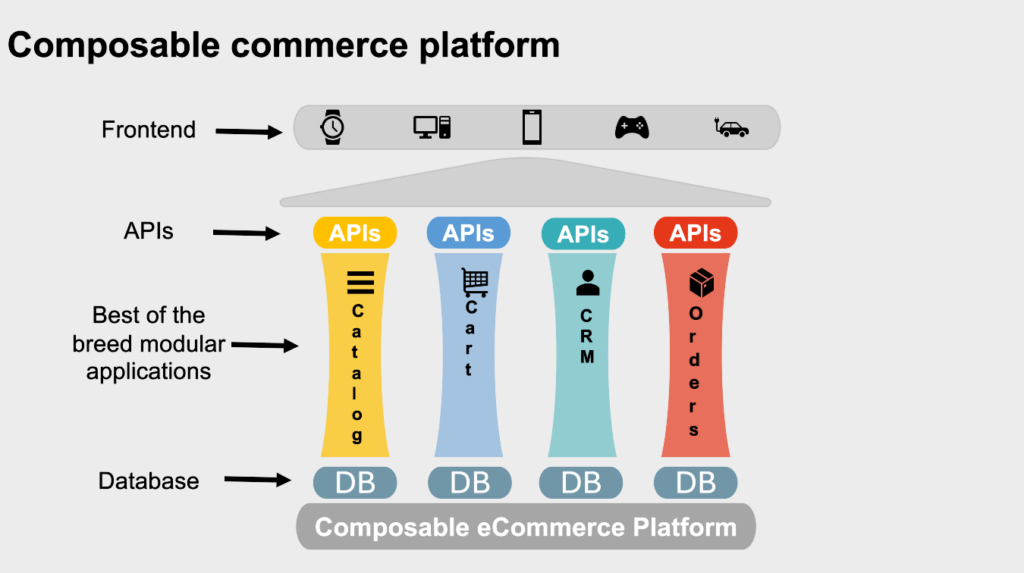Written By SKILLNET, Reviewed ON 15-09-2022
Updated by Neeta, Updated On 10-09-2022,
The world around us is changing rapidly. Everything is now available online at the tip of your finger. In this ever-evolving landscape, the significance of crafting a dynamic online presence cannot be overstated. As we navigate through 2024, businesses are witnessing a crucial moment in the way e-commerce operates.
The rise of digital transactions, coupled with shifting consumer behavior, has ushered in a new era. Today, adaptability and innovation are paramount.
Enter Soluções Escaláveis, a transformative approach that resonates profoundly in the current market landscape. Imagine this as the backstage pass to crafting a bespoke e-commerce experience tailored to the unique needs of your business. It’s the antidote to one-size-fits-all solutions. But why invest in it?
Well, composable commerce offer enterprises the flexibility and modularity needed to stay ahead. We will be examining its relevance and unveiling the secrets to sculpting a future-ready e-commerce platform.
It doesn’t matter if you’re a seasoned player in the industry or a newcomer looking to carve your niche. Understanding and embracing Composable Commerce is the compass that guides your business toward unparalleled flexibility, innovation, and sustained success.
So, let’s unlock the potential that Composable Commerce holds for your venture in 2024 and beyond.

The Strategic Advantage of Composable Commerce solutions
In today’s hyper-competitive e-commerce landscape, agility is crucial to success. Monolithic platforms often need help to keep pace with rapidly changing consumer preferences and technological advancements. In contrast, Composable Commerce offers businesses a strategic advantage by providing the flexibility and scalability needed to stay ahead of the curve.
One of the key benefits of Composable Commerce is its modular architecture, a foundation built on the principles of MACH (Microservices, API-first, Cloud-native, and Headless). The MACH architecture allows businesses to mix and match different components to build e-commerce websites with greater flexibility. This modular approach enhances flexibility. It also facilitates faster time-to-market. Companies can leverage pre-built components rather than starting from scratch.
Need help with Composable Commerce Strategy and implementation?
Furthermore, Composable Commerce empowers businesses to future-proof their e-commerce infrastructure. This is done by embracing emerging technologies and trends. Whether it’s implementing AI-powered personalization or integrating voice commerce capabilities, Composable Commerce provides businesses with the agility to adapt to evolving consumer preferences and market dynamics.
Now, since we are sure of its potential, All that’s left to do is start building your composable commerce site.
Adopting Composable Commerce
Building with Composable Commerce requires careful planning and execution. Here are the steps to help you create an optimal e-commerce website using MACH architecture.
Step 1: Understand Composable Commerce
- Dive deep into the concept of Soluções Escaláveis. Understand its core principles and how it differs from traditional monolithic e-commerce platforms.
- Explore case studies and success stories of businesses that have adopted Composable Commerce. Gain insights into its benefits and challenges.
- Familiarize yourself with the latest trends and developments in the Composable Commerce space. Stay abreast of emerging technologies and best practices.
Step 2: Research
- Conduct thorough research into the latest trends and technologies in e-commerce for 2024. Analyze consumer behavior, market dynamics, and competitor strategies.
- Identify key areas of opportunity and differentiation for your e-commerce website. Consider factors such as target audience demographics, niche markets, and emerging industry trends.
- Gather insights from industry reports, market studies, and expert opinions. Ensure the latest market intelligence keeps your e-commerce strategy informed.
Step 3: Choose the Right Platform
- Evaluate different Composable Commerce platforms based on your business needs and goals. Considering factors such as scalability, flexibility, ease of integration, and cost-effectiveness.
- Look for platforms that offer a wide range of modular services and integrations. This allows you to customize your e-commerce experience and adapt to changing market demands.
- Consider factors such as vendor reputation, customer reviews, and platform stability when making your decision. Ensure that you choose a reliable and trustworthy partner for your e-commerce journey.

Step 4: Identify Core Components
- Determine the essential components of your e-commerce website. These include product catalog management, checkout processes, payment gateways, shipping, and customer support.
- Prioritize features and functionalities based on their importance to your business objectives and target audience preferences. Ensure your website meets the needs of your customers effectively.
Step 5: Select Modular Services
- Choose modular services and APIs for each core component of your e-commerce website. Select vendors based on factors such as functionality, reliability, and compatibility.
- Consider factors such as ease of integration, documentation quality, and support availability when evaluating different service providers. Ensure seamless integration and optimal performance.
- Negotiate pricing and licensing terms with vendors. Seek to maximize value while minimizing costs. Ensure your chosen services align with your budget constraints and scalability requirements.
Step 6: Customization
- Customize each component of your e-commerce website to fit your brand identity and user experience goals. Leverage the flexibility of Composable Commerce to create a compelling e-commerce experience.
- Work closely with designers, developers, and UX/UI specialists to tailor the look and feel of your website. This is to resonate with your target audience and differentiate your brand from competitors.
- Implement personalized features and functionalities. These include product recommendations, dynamic pricing, and interactive shopping experiences. It enhances user engagement and drives conversions.
Step 7: Integração
- Integrate all selected services and APIs into your e-commerce platform. Ensure that they communicate effectively with each other and provide a cohesive user experience.
- Test integrations thoroughly to identify and resolve any compatibility issues or performance bottlenecks. Ensure that your website operates smoothly across different devices and browsers.
- Implement robust monitoring and analytics tools to track website performance and user behavior. Gain insights into customer interactions and identify areas for optimization and improvement.
Step 8: Testing
- Conduct comprehensive testing of your e-commerce website to identify and fix any bugs or issues before launch. Ensure a seamless and error-free user experience.
- Test website functionality across various devices, browsers, and operating systems. Ensure compatibility and responsiveness across different platforms.
- Perform usability testing with real users to gather feedback on website navigation, user interface design, and overall user experience. Iterate on design and functionality based on user feedback.
Step 9: Launch
- Once testing is complete, launch your e-commerce website. Make it available to the public and promote it through marketing channels. You can do it via social media, email campaigns, and search engine optimization.
- Monitor website performance closely during the launch phase. Track key metrics such as traffic, conversion rates, and revenue. Address any issues or concerns promptly.
- Celebrate the launch of your e-commerce website team and stakeholders. Recognize their hard work and dedication in bringing your vision to life.
Step 10: Iterate and Improve
- Continuously iterate and improve your e-commerce on user feedback, market trends, and technological advancements.
- Stay flexible and adaptable in the ever-changing e-commerce landscape.
- Implement A/B testing and multivariate testing to experiment with different website elements and strategies. Optimize performance and maximize conversions.
- Stay informed about the latest developments in Composable Commerce and e-commerce best practices. Attend industry events, network with peers, and invest in ongoing education and training for your team.
By following these steps, you can create an innovative website with Composable Commerce. But optimizing an e-commerce website is just the beginning of the journey. To ensure long-term success, businesses must invest in ongoing testing, optimization, and iteration.
Need help with Composable Commerce Strategy and implementation?
Although, Iterating with Composable Commerce is a continuous process. Businesses must constantly look for ways to optimize and enhance their e-commerce experience. Composable Commerce provides the flexibility and agility businesses need to stay ahead of the curve.
Building a flexible and innovative e-commerce website with Composable Commerce offers numerous benefits. It can also be a complex and time-consuming process. That’s where we come in. With our expertise in Composable Comércio, we can help streamline the process. We ensure your e-commerce website is optimized for success.
By partnering with us, you’ll not only save time and resources but also gain access to our industry-leading expertise and insights. If you’re a large enterprise, we have the knowledge and experience to help you unlock the full potential of Composable Commerce. We can take your e-commerce business to the next level.
Conclusion
It’s clear that this revolutionary approach offers businesses unparalleled flexibility, innovation, and strategic advantage in the ever-evolving e-commerce landscape. By embracing Composable Commerce, companies can unlock new opportunities for growth, differentiation, and success in 2024 and beyond.
Rewriting the e-commerce narrative requires a bold vision. It is a willingness to embrace change and a commitment to continuous improvement. Now is the time to embrace Soluções Escaláveis and unleash the full potential of your e-commerce venture.
Start the journey to the future of e-commerce with Composable Commerce. Together, let’s build a brighter, more innovative tomorrow.
Planning to build a Future-Proof composable commerce website in 2024? Read additional resources below
- Check out our blog on how to choose right partner for your e-commerce replatforming
- For more information check out our blog – exploring microservices architecture for composable commerce
- You may need DXP for best personalization functionality. Know more about DXP for power of personalization
- Read our blog Composable Commerce vs Headless: What’s Best for Your eCommere site?






 Engenharia
Engenharia










